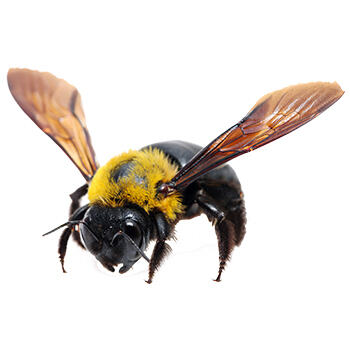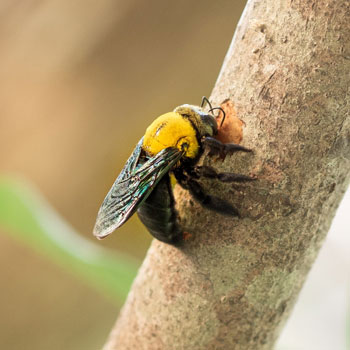Carpenter Bee Treatment
Protecting your property in Atlanta, Augusta, Fayetteville, Woodstock, Suwanee, Marietta, Hiram, and Aiken SC from pests is an important part of home and business ownership. Some types of pests are a threat to the people inside your building while others are a threat to the structure of your property. Wood-destroying organisms are among the most destructive types of pests that building owners face. Carpenter bees are a type of wood-destroying pest that can leave the wood around your home or business with unsightly damage. To protect your home or business from carpenter bees, you need to learn about the behavior of this pest, take steps for prevention, and find effective carpenter bee treatment options should an infestation occur.

What are Carpenter Bees?
Carpenter bees are a large species of bees that can be found throughout Atlanta, Augusta, Fayetteville, Woodstock, Suwanee, Marietta, Hiram, and Aiken SC. This big black bee looks similar to bumblebees but can be accurately identified when you understand the differences between the two. The female can sting humans but will only do so if provoked. The male carpenter bee does not have a stinger and does not pose a threat. Female carpenter bees bore holes into wood to build their nests and lay eggs. This creates round holes in the wood that can be found in many different areas around your home or business including siding, fences, trees, lawn furniture, and swing sets.
Understanding the Carpenter Bee Life Cycle
Carpenter bees undergo a complete metamorphosis, with a life cycle consisting of four stages: egg, larva, pupa, and adult. The female lays her eggs inside the wooden tunnels she excavates, providing each with a ball of pollen and nectar as food for the developing larvae. The larvae feed on this provision, grow, and eventually pupate within the tunnel.
New adult bees typically emerge in late summer or early fall. These adults may either create new tunnels or overwinter in existing ones, emerging again the following spring to mate and begin the cycle anew. This means that addressing infestations requires understanding their seasonal activity.
Understanding Carpenter Bee Behavior
Carpenter bees are solitary bees; unlike honeybees or bumblebees, they don’t live in colonies. The males are often seen hovering around nesting sites, appearing aggressive, but they lack a stinger and are harmless. Female carpenter bees can sting, but they rarely do unless directly provoked. Carpenter bees are not wood-eaters; they only tunnel into wood to create nesting galleries. You might notice sawdust near the entrance holes, a telltale sign of their activity.
How Do I Identify Carpenter Bees?
Carpenter bees are easy to confuse with bumblebees because they have several physical similarities. The size, shape, and coloring of these two types of bees are similar. One noticeable physical difference between the two can be found on the abdomen. Bumblebees have a fuzzy abdomen while carpenter bees have a shiny black abdomen. You can also distinguish carpenter bees from other types of bees by their behavior. Bumblebees live in colonies with many others, but carpenter bees are solitary and only share their nest with a mate and eggs. The females spend their time excavating wood for their nests, while the males play the role of protector against threats. The behavior of male carpenter bees can seem aggressive when they encounter a threat, but they do not have a stinger and are not a physical threat.
Frequently Asked Questions About Carpenter Bees:
How Did I Get Carpenter Bees?
Carpenter bees are a common sight in eastern states such as Atlanta, Augusta, Fayetteville, Woodstock, Suwanee, Marietta, Hiram, and Aiken SC. If you have wood on or around your home or business, you are at risk for developing a carpenter bee problem. These pests bore into softwoods like pine and cedar to build their nests and lay eggs.

What Are the Effects of Carpenter Bees in and Around My Home or Business?
Carpenter bees can cause unsightly damage to your structure. Female carpenter bees bore holes into wood. The holes they create are large enough for them to enter and lay their eggs. Since these pests range in size from ¾ of an inch to 1 inch, the holes are large enough to be easily noticed. This can cause significant visible damage to your home or business. If you have unexplained holes in the wood around your house and notice fine sawdust nearby, it is a possible indication that you have a carpenter bee infestation. Look for these holes in wooden areas around your house or business such as your deck, swing set, eaves, siding, patio furniture, or any wood surface.
Carpenter bees create conditions that attract woodpeckers who feed on bee larvae within the wood Peachtree Pest’s Service Director. “If you have an issue with woodpeckers pecking on your house or shed, there’s a good chance they’re trying to get carpenters, silverfish or other insects.”
How Long Do Carpenter Bees Live?
In Atlanta, Augusta, Fayetteville, Woodstock, Suwanee, Marietta, Hiram, and Aiken SC, carpenter bees can show up at your home or business in the spring and stay active throughout the summer. Female carpenter bees lay eggs in their nests during the warm months. As the cool weather approaches, they winter in the nests they created in the wood.
Without carpenter bee treatment, a new generation will emerge and repeat the cycle. Once eggs develop into adults, they leave the nest and go out on their own to bore more holes and lay more eggs.
How Do I Prevent Carpenter Bees?
A professional carpenter bee treatment can help protect your home or business from the damage these pests create.
A big part of effective carpenter bee prevention is learning about their behavior and preferences. Carpenter bees need nectar to survive. There is no way for you to eliminate the availability of nectar around your property, so you must focus on other aspects of their behavior, such as where they are most active and what types of wood they prefer.

Common areas around your home or business where carpenter bees tunnel include eaves, wood shingles, window and door trim, fascia boards, porches, decks, swing sets, wood railings, and fence posts. You can keep an eye out for carpenter bee activity around these areas once spring arrives by doing regular inspections. Discovering the presence of these pests around your property will allow you to act before they have the opportunity to cause widespread damage.
Carpenter bees prefer to build their nests in unpainted softwoods such as redwood, spruce, pine, cedar, cypress, and fir. Painting over areas of exposed wood can help you in your carpenter bee prevention efforts by making the wood less attractive to the female carpenter bee. Painting the wood on your building will provide an extra layer of protection against this destructive pest, but don’t fill in or paint over carpenter bee holes without having them treated professionally.
Successful carpenter bee prevention in Atlanta, Augusta, Fayetteville, Woodstock, Suwanee, Marietta, Hiram, and Aiken SC often requires the help of a professional carpenter bee professional. Before the spring arrives, you can bring in a pro to inspect your property for signs of previous carpenter bee activity. If nests are discovered, carpenter bee treatment can prevent the reemergence of these insects in the spring. When the weather warms up, a carpenter bee control professional can spot signs of activity and eliminate the carpenter bees before they do significant damage.

What is the best repellent for carpenter bees?
When it comes to how to get rid of carpenter bees, the quickest and most effective way to eliminate these pests is often through professional carpenter bee treatment. Trained technicians can accurately identify active nesting sites and apply targeted treatments using specialized products and application methods. This ensures thorough elimination of the current population and any larvae within the tunnels.
Professionals (like you’ll find here at Peachtree Pest Control) can also provide expert advice on sealing existing holes and implementing preventative strategies to discourage future nesting, offering a fast and reliable solution.
What is the fastest way to get rid of carpenter bees?
While some do-it-yourself tactics, such as applying a fresh coat of paint or certain essential oil mixtures to wood surfaces, might offer a temporary solution for repelling carpenter bees, the most dependable and effective long-term strategies to truly deter carpenter bees often necessitate the expertise of professional pest control services.
Our trained technicians can conduct a thorough assessment of your property, identifying areas particularly susceptible to carpenter bee activity, and apply professional-grade repellent treatments to vulnerable wood surfaces, leveraging our in-depth understanding of carpenter bee behavior.
We can also provide informed advice on structural modifications and implement proactive preventative measures around your home that create a significantly less attractive environment for these wood-boring pests, ultimately delivering a comprehensive and lasting solution to protect your property.
How much damage can carpenter bees do?
Carpenter bee holes created for nesting can lead to significant structural damage to wooden elements over time, even though these bees aren’t as immediately destructive as termites. Their tunneling weakens decks, fences, siding, and other wooden structures.
Repeated nesting in the same areas can lead to extensive networks of tunnels, increasing the risk of water intrusion and wood rot. Addressing these infestations early with professional pest control services can prevent escalating damage and costly repairs down the line.
Should carpenter bees be removed?
Yes, carpenter bee removal is advised when you observe them actively creating nesting galleries within the wooden elements of your property. While carpenter bees do play a role in pollination, their persistent wood-boring behavior can lead to significant compromises in the structural integrity and aesthetic appeal of your home’s decks, porches, siding, and other wooden features.
Professional pest control services offer the safest and most effective methods for carpenter bee removal, going beyond simply eliminating visible bees to ensure thorough treatment of the intricate nest systems and preventing future infestations. This comprehensive approach provides lasting protection for your home from potential damage and helps maintain its value.
How worried should I be about carpenter bees?
If you observe carpenter bees drilling into the wood around your home, it’s wise to take the situation seriously. While they are not typically aggressive, the structural damage they cause through tunneling can become a significant issue if left unaddressed, potentially affecting the longevity and value of your residence.
Early intervention with professional carpenter bee pest control services is key to preventing extensive damage and ensuring the long-term integrity of your wooden structures. Our pest control experts can assess the infestation and implement targeted solutions to eliminate carpenter bees and protect your property.
Carpenter Bee Treatment
Peachtree Service Professionals perform a carpenter bee service over a 2-month period. The 1st service involves a detailed inspection of the structure and a targeted treatment of holes and surrounding areas to eliminate existing adults and larvae.
During this initial visit, our experienced technicians will conduct a thorough assessment to identify all active carpenter bee nesting sites. The primary method of treatment at this stage involves spraying for carpenter bees with professional-grade insecticides directly into the identified carpenter bee holes and on surrounding wood surfaces where activity is evident. This targeted application ensures direct contact with the adult bees and helps to eliminate the developing larvae within the tunnels.
The 2nd service, approx. 1 month later, involves another inspection, hole treatment where needed. The final step is filling the previous holes with putty to deter carpenter bees from emerging from holes or reinfesting. The putty comes in 3 common colors to match as close as possible.
This service can involve intensive ladder work as carpenter bees often infest roofline areas. Our carpenter bee service has a warranty for 90 days, starting at the first service.
Repairing Carpenter Bee Damage
If carpenter bees have already damaged your property, addressing the issue promptly is crucial. First, any existing carpenter bees should be eliminated. Then, the damaged wood needs to be repaired. Small holes can be filled with wood filler or dowels. For more extensive damage, replacing the affected wood may be necessary.
To prevent future nesting in the repaired areas, be sure to paint or seal the wood after repairs are complete. Peachtree Pest Control can not only eliminate carpenter bees but also advise on the necessary repairs to restore your property.
Protecting Your Home or Business From Carpenter Bees With Peachtree Pest Control
Peachtree Pest Control offers expert treatment designed to effectively and efficiently control and prevent pests from invading your home or business in Atlanta, Augusta, Fayetteville, Woodstock, Suwanee, Marietta, Hiram, and Aiken SC. Our use of Integrated Pest Management (IPM) techniques focuses on finding the core of the pest concern and controlling Carpenter Bees from the source. Through IPM, pest control materials are selected and applied in a manner that minimizes risks to human health, pets, and the environment.
Entrusting your carpenter bee removal needs to Peachtree Pest Control provides numerous advantages for effective and lasting solutions:
- Our experienced pest control technicians are trained to accurately identify the extent of the infestation and implement the most effective carpenter bee treatment strategies for your property.
- We go beyond simply addressing the visible bees, targeting the nesting sites to eliminate current populations and prevent future activity.
- We provide expert advice and implement preventative measures designed to deter carpenter bees from returning to your wooden structures.
- Our comprehensive approach offers a lasting solution that protects your home and peace of mind.
- We utilize our in-depth understanding of carpenter bee behavior to tailor treatments to your specific needs.
Contact Peachtree Pest Control today for your FREE and NO OBLIGATION estimate at 855-732-2487 or Schedule Online today!






